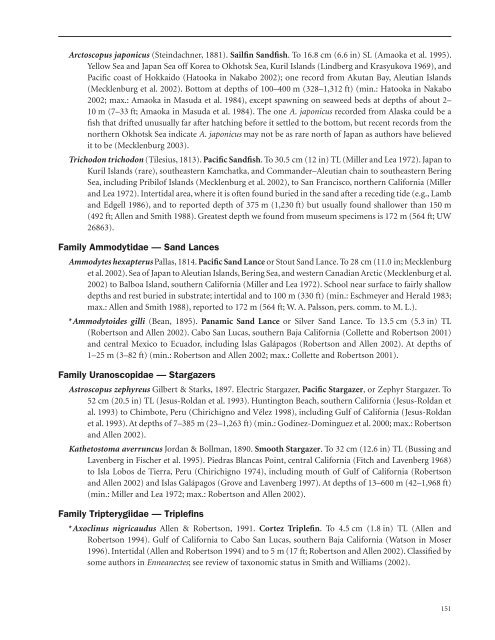Untitled - Alaska Resources Library
Untitled - Alaska Resources Library
Untitled - Alaska Resources Library
You also want an ePaper? Increase the reach of your titles
YUMPU automatically turns print PDFs into web optimized ePapers that Google loves.
Arctoscopus japonicus (Steindachner, 1881). Sailfin Sandfish. To 16.8 cm (6.6 in) SL (Amaoka et al. 1995).<br />
Yellow Sea and Japan Sea off Korea to Okhotsk Sea, Kuril Islands (Lindberg and Krasyukova 1969), and<br />
Pacific coast of Hokkaido (Hatooka in Nakabo 2002); one record from Akutan Bay, Aleutian Islands<br />
(Mecklenburg et al. 2002). Bottom at depths of 100–400 m (328–1,312 ft) (min.: Hatooka in Nakabo<br />
2002; max.: Amaoka in Masuda et al. 1984), except spawning on seaweed beds at depths of about 2–<br />
10 m (7–33 ft; Amaoka in Masuda et al. 1984). The one A. japonicus recorded from <strong>Alaska</strong> could be a<br />
fish that drifted unusually far after hatching before it settled to the bottom, but recent records from the<br />
northern Okhotsk Sea indicate A. japonicus may not be as rare north of Japan as authors have believed<br />
it to be (Mecklenburg 2003).<br />
Trichodon trichodon (Tilesius, 1813). Pacific Sandfish. To 30.5 cm (12 in) TL (Miller and Lea 1972). Japan to<br />
Kuril Islands (rare), southeastern Kamchatka, and Commander–Aleutian chain to southeastern Bering<br />
Sea, including Pribilof Islands (Mecklenburg et al. 2002), to San Francisco, northern California (Miller<br />
and Lea 1972). Intertidal area, where it is often found buried in the sand after a receding tide (e.g., Lamb<br />
and Edgell 1986), and to reported depth of 375 m (1,230 ft) but usually found shallower than 150 m<br />
(492 ft; Allen and Smith 1988). Greatest depth we found from museum specimens is 172 m (564 ft; UW<br />
26863).<br />
Family Ammodytidae — Sand Lances<br />
Ammodytes hexapterus Pallas, 1814. Pacific Sand Lance or Stout Sand Lance. To 28 cm (11.0 in; Mecklenburg<br />
et al. 2002). Sea of Japan to Aleutian Islands, Bering Sea, and western Canadian Arctic (Mecklenburg et al.<br />
2002) to Balboa Island, southern California (Miller and Lea 1972). School near surface to fairly shallow<br />
depths and rest buried in substrate; intertidal and to 100 m (330 ft) (min.: Eschmeyer and Herald 1983;<br />
max.: Allen and Smith 1988), reported to 172 m (564 ft; W. A. Palsson, pers. comm. to M. L.).<br />
*Ammodytoides gilli (Bean, 1895). Panamic Sand Lance or Silver Sand Lance. To 13.5 cm (5.3 in) TL<br />
(Robertson and Allen 2002). Cabo San Lucas, southern Baja California (Collette and Robertson 2001)<br />
and central Mexico to Ecuador, including Islas Galápagos (Robertson and Allen 2002). At depths of<br />
1–25 m (3–82 ft) (min.: Robertson and Allen 2002; max.: Collette and Robertson 2001).<br />
Family Uranoscopidae — Stargazers<br />
Astroscopus zephyreus Gilbert & Starks, 1897. Electric Stargazer, Pacific Stargazer, or Zephyr Stargazer. To<br />
52 cm (20.5 in) TL (Jesus-Roldan et al. 1993). Huntington Beach, southern California (Jesus-Roldan et<br />
al. 1993) to Chimbote, Peru (Chirichigno and Vélez 1998), including Gulf of California (Jesus-Roldan<br />
et al. 1993). At depths of 7–385 m (23–1,263 ft) (min.: Godinez-Dominguez et al. 2000; max.: Robertson<br />
and Allen 2002).<br />
Kathetostoma averruncus Jordan & Bollman, 1890. Smooth Stargazer. To 32 cm (12.6 in) TL (Bussing and<br />
Lavenberg in Fischer et al. 1995). Piedras Blancas Point, central California (Fitch and Lavenberg 1968)<br />
to Isla Lobos de Tierra, Peru (Chirichigno 1974), including mouth of Gulf of California (Robertson<br />
and Allen 2002) and Islas Galápagos (Grove and Lavenberg 1997). At depths of 13–600 m (42–1,968 ft)<br />
(min.: Miller and Lea 1972; max.: Robertson and Allen 2002).<br />
Family Tripterygiidae — Triplefins<br />
*Axoclinus nigricaudus Allen & Robertson, 1991. Cortez Triplefin. To 4.5 cm (1.8 in) TL (Allen and<br />
Robertson 1994). Gulf of California to Cabo San Lucas, southern Baja California (Watson in Moser<br />
1996). Intertidal (Allen and Robertson 1994) and to 5 m (17 ft; Robertson and Allen 2002). Classified by<br />
some authors in Enneanectes; see review of taxonomic status in Smith and Williams (2002).<br />
151
















